Owned and operated by Matt Soper, Hampshire Carnivorous Plants is one of the best known specialist nurseries in the UK.
I bought some of my first Sarracenia from Matt over 15 years ago, and I’ve attended many of his fantastic open days in the years since. Matt is currently preparing for the nursery’s 20th year exhibiting at the Chelsea Flower Show, an event which he hopes will also mark their 20th consecutive gold medal. I caught up with Matt about his plans for 2018, his past trips to see carnivorous plants in the wild, and the many named cultivars produced by his famous Sarracenia hybridisation program.
Enjoy, and be sure to subscribe to Tom’s Carnivores for more stories like this!
For the benefit of any growers who’ve not yet discovered your nursery, could you introduce yourself?
My name’s Matthew Soper and my nursery is Hampshire Carnivorous Plants. I’ve been growing carnivorous plants from the age of 7, and I started off with a Venus flytrap - I’d seen them on a natural history program. I was fascinated by the Venus flytrap, and a neighbour managed to find one in my local garden centre. That was my first carnivorous plant. I think I killed it after about 2 or 3 days!
After that, I grew carnivorous plants on and off as a hobby. I mainly grew them from seed, sent over from various different places, because many plants were very hard to get hold of back then. I amassed quite a large collection and started the nursery - Hampshire Carnivorous Plants - in about 1995. We attended our first flower show in 1996: Southampton Flower and Balloon Festival.
From there I kept selling to friends and family, slowly built the nursery up, and eventually started doing RHS flower shows. We attended our first RHS Chelsea show in 1999, and we fortunately won a gold medal, and we’ve been at Chelsea ever since. This year will be our 20th time at the Chelsea Flower Show, and fingers crossed it’ll be our 20th consecutive gold medal as well.
Click on any photo to zoom in. Use arrow keys or swipe to navigate.
 01. Preparation for the 2017 Chelsea Flower Show
01. Preparation for the 2017 Chelsea Flower Show 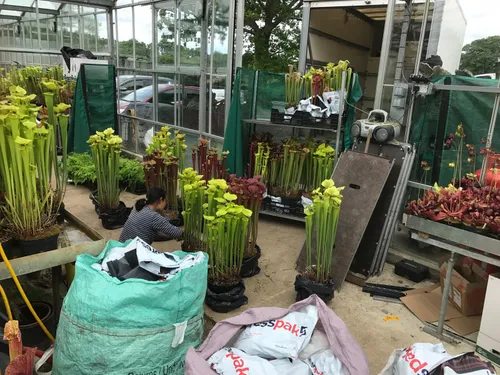 02. Specimen plants are loaded into the van for the 2017 Chelsea Flower Show
02. Specimen plants are loaded into the van for the 2017 Chelsea Flower Show  03. Some stunning forms of Sarracenia flava ready for display
03. Some stunning forms of Sarracenia flava ready for display  04. Fon with some of their stunning display plants
04. Fon with some of their stunning display plants 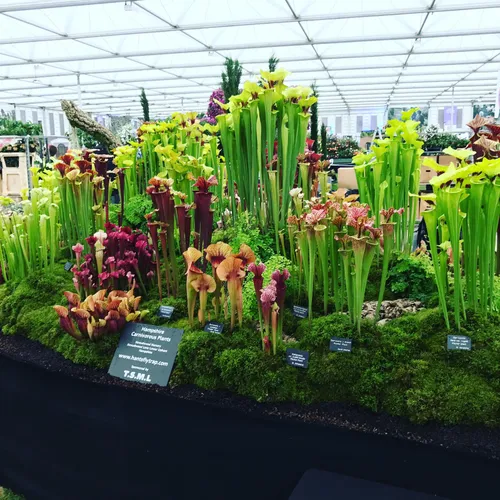 05. The finished display at the 2017 Chelsea Flower Show
05. The finished display at the 2017 Chelsea Flower Show  06. A 19th Chelsea Gold for Matt Soper and Hampshire Carnivorous Plants
06. A 19th Chelsea Gold for Matt Soper and Hampshire Carnivorous Plants So at what point did you make the transition from running the nursery as a hobby, to it becoming your full time job?
I’ve always been self-employed, but I’m a builder by trade, which is very handy! I constructed some of the nursery as well.
Round about 1997 I went full time. It was difficult, I’ll be honest - it’s always a lot of work. But we got there.
And who helps you operate the nursery today?
My wife Juthatip does a lot of the packing for the mail order, my daughter Rebecca helps out with some of the bookwork, and we also have one employee Fon who works mornings on the nursery and is a great Sarracenia grower! So it’s mainly a family business.
This year you’re running two open weekends, is that right?
Yes: the first is 28th and 29th April, which should be really good for people who are keen on their Sarracenia. You’ll be able to see them in flower, which is the best time of year for them.
We normally have an open weekend later in the season in August, but this year it’s 21st and 22nd July. This will be just after our exhibit at Hampton Court Flower Show, which will be very special for us - it’s our 20th year at the show. This year we’ve been awarded the RHS Master Grower award, which is a complete honour for us. It’s the first time a carnivorous plant nursery has been awarded this, so we will be putting on a much larger display than usual.
It sounds like a busy year for you! You don’t normally run open days that early in the season - it should be nice for people to see the plants in Spring?
Definitely, in fact both of them will be better for the plants. In the past, we’ve scheduled the open weekends around the flower shows, but we’ve dropped Tatton Park Flower Show this year and replaced it with the later open weekend. We’ve also added this new early weekend in April, because - being honest - the plants look a lot better!
As a grower you’ll know August isn’t the best time for the plants. That’s why we weren’t doing flower shows in August, because there’s a bit of a lull before they pick up again in September. Now we’re going to have the open weekends when the plants are looking their best.
I’m looking forward to it! I also wanted to ask about your field trips - you’ve travelled to see carnivorous plants in the wild, is that right?
Yeah that’s right, I’ve seen Nepenthes in Peninsula Malaysia, Thailand, Laos, Vietnam, Borneo, and Sumatra. My wife’s Thai, so I’ve spent a lot of time in the Far East. We’ve been married for 25 years now. Whenever we went back to Thailand I used to make excursions to look at plants!
Click on any photo to zoom in. Use arrow keys or swipe to navigate.
 01. On the ascent up Gunung Pangulubao, Sumatra
01. On the ascent up Gunung Pangulubao, Sumatra  02. Matt and his guides at the top of Gunung Pangulubao
02. Matt and his guides at the top of Gunung Pangulubao 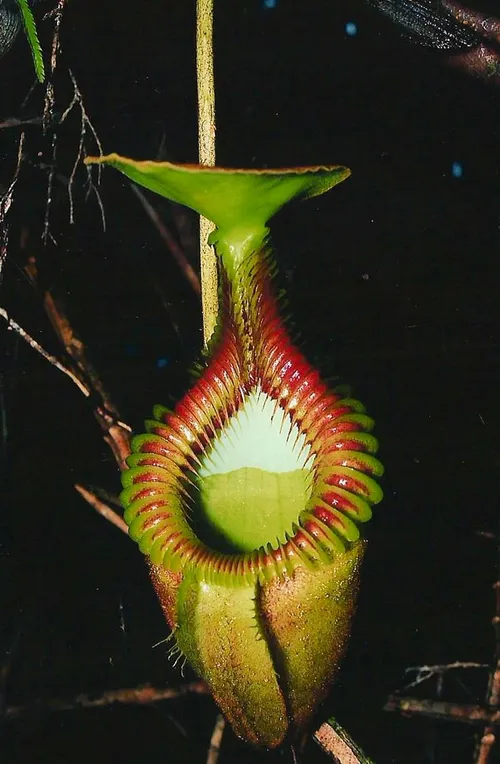 03. Matts photo of Nepenthes villosa in Borneo
03. Matts photo of Nepenthes villosa in Borneo 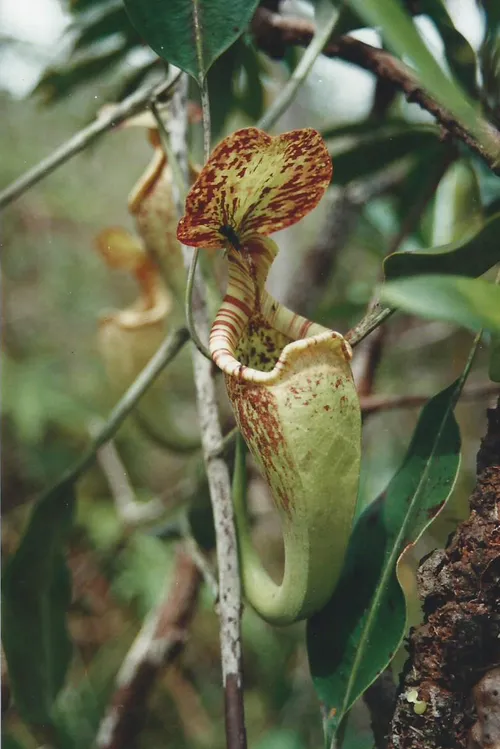 04. Nepenthes rafflesiana
04. Nepenthes rafflesiana  05. Nepenthes x kinabaluensis, the natural hybrid between N. rajah and N. villosa, named after Mount Kinabalu in Borneo
05. Nepenthes x kinabaluensis, the natural hybrid between N. rajah and N. villosa, named after Mount Kinabalu in Borneo  06. Matt with Nepenthes lowii on Mount Kinabalu, Borneo
06. Matt with Nepenthes lowii on Mount Kinabalu, Borneo  07. Nepenthes lowii, Mount Kinabalu
07. Nepenthes lowii, Mount Kinabalu  08. Nepenthes x harryana, the natural hybrid between N. edwardsiana and N. villosa in Borneo
08. Nepenthes x harryana, the natural hybrid between N. edwardsiana and N. villosa in Borneo And do you still go on field trips today?
Not as much, no - I was back there in January, but I went up north to Chiang Mai. Northwest Thailand there doesn’t seem to be any Nepenthes; I looked for them up the mountains, but there weren’t any. You find them in the Northeast, where it borders with Laos. There should be some in Burma, they’ve got the right altitude for them, where it comes down the peninsula alongside Thailand, but it’s not easy to travel freely around Burma. But as far as Northwest Thailand goes, no, we never found any there, only Sundews.
I don’t often go out looking for them these days, because the nursery has taken up a lot of my time over the last few years.
The only Nepenthes I’ve seen in the wild is Nepenthes pervillei, in the Seychelles, but I’m planning a trip to Borneo in the next year or two. Which mountains in Borneo did you climb?
Mount Kinabalu in Sabah is the easiest one to see Nepenthes, although it’s surprisingly difficult to see lots of different species in a single trip. I climbed Mount Kinabalu in 1993, and saw N. fusca, N. tentaculata, N. villosa, N. lowii, N. × harryana, and N. x kinabaluensis … we didn’t see N. rajah. So that’s 6! But I had the handbook, Nepenthes of Mount Kinabalu, which had pages and pages of Nepenthes and I was expecting to see the whole lot! But that’s not the case.
I’ve been out to Sumatra 3 times. I spent two weeks out there climbing Gunung Pangulubao, Gunung Sibayak, Sibolga, and Bukit Luang. Pangulubao is around 1800m. I managed to find a guide in the town, and all I saw up on that mountain was N. spectabilis, N. ovata, and N. rhombicaulis. And that was an epic trip! It took a while to arrange everything on my own and come back down again, and I saw just the 3 species.
Compare that with the States - on a flydrive from Disneyland, you can see all of them in 2 weeks! Sarracenia is easy by comparison. Nepenthes are quite hard work, since many species are endemic to certain mountains. You go up there, and there’s not much else apart from that species.
Click on any photo to zoom in. Use arrow keys or swipe to navigate.
 Matt's photo of Sarracenia flava fields in the US
Matt's photo of Sarracenia flava fields in the US  Red tube forms of Sarracenia flava
Red tube forms of Sarracenia flava What are you most passionate about growing today?
Sarracenia hybrids, 100%. That is what I’m interested in, almost solely! Looking ahead, I don’t think there’s enough time for what I want to do with them! I’m currently germinating last year’s batch, and I already know what I want to cross those with. There’s some crackers that’ll be coming up. It’s great fun. I love hybridising Sarracenia.
I remember in the past, I was like a lot of other growers: species all the way. Wasn’t the slightest bit interested in hybrids, and I just poo-poo’d hybrids like everyone did. But now, it’s just gone completely the other way! When I look at other groups of plants, it sort of dawns on me why when you look at fuschias they’re all hybrids, roses are mainly hybrids, and so on. Because you can come up with vigorous, strong, colourful plants that are reliable, look great, and hang on every year.
For me, vigor is as important in hybrids as anything else.
Click on any photo to zoom in. Use arrow keys or swipe to navigate.
 A selected form of Sarracenia x moorei, the cross between S. flava and S. leucophylla
A selected form of Sarracenia x moorei, the cross between S. flava and S. leucophylla  A selected seedling of Sarracenia cv. Peaches x Sarracenia cv. Asbo
A selected seedling of Sarracenia cv. Peaches x Sarracenia cv. Asbo  Sarracenia cv. Rita Soper x Sarracenia cv. Leah Wilkerson
Sarracenia cv. Rita Soper x Sarracenia cv. Leah Wilkerson  Sarracenia x moorei, Pensacola Fields
Sarracenia x moorei, Pensacola Fields I guess part of what’s come out of that passion is the cultivars you’ve named for your wife and daughter, is that right?
Yes, I’ve named Sarracenia cv. ‘Juthatip Soper’ for my wife, and Sarracenia ‘Daisy Soper’ for one of my daughters, and a Nepenthes for my eldest daughter Rebecca.
This year at Chelsea we will be naming 2 cultivars. First is Sarracenia flava var rubricorpra cv. ‘Roy Lancaster’: this is a really nice form which I originally grew on from wild collected seed some 25 years ago. It’s outstanding in form, colour and habit with beautiful tall upright pitches which colour up a lovely dark red later in the season, with a contrasting yellow mouth and beautiful red veined yellow lid. It produces bright sulphur yellow flowers in Spring. It was a pleasure for me to name a plant for Roy Lancaster who has encouraged and supported us over the years.
Sarracenia flava var maxima cv. ‘James Wong’ is the resulting seedling of a Sarracenia flava var maxima that I self-pollinated some years ago. It’s extremely vigorous, produces tall bright lime green foliage sometimes to over a metre and bright sulphur yellow flowers in Spring. It’s extremely hardy outside year round in a peat bog garden or well suited to an unheated greenhouse.
I’ll be naming a few more hybrids this year. We’ve got a lot of plants with code numbers, and we’ve got to start naming them because otherwise they get lost. Cultivar names keep them in cultivation so they don’t get forgotten about.
Click on any photo to zoom in. Use arrow keys or swipe to navigate.
 01. Matt and his wife Juthatip with Sarracenia cv. Juthatip Soper, a selected form of Sarracenia x mitchelliana
01. Matt and his wife Juthatip with Sarracenia cv. Juthatip Soper, a selected form of Sarracenia x mitchelliana  02. The beautiful pitchers of Sarracenia Juthatip Soper
02. The beautiful pitchers of Sarracenia Juthatip Soper  03. Nepenthes cv Rebecca Soper, a cross between N.ramispina and N. ventricosa that Matt named after his daughter
03. Nepenthes cv Rebecca Soper, a cross between N.ramispina and N. ventricosa that Matt named after his daughter  04. Sarracenia cv Daisy Soper with its namesake
04. Sarracenia cv Daisy Soper with its namesake  05. Sarracenia Roy Lancaster, a selected form of Sarracenia flava var rubricorpra
05. Sarracenia Roy Lancaster, a selected form of Sarracenia flava var rubricorpra  06. Sarracenia Roy Lancaster, a selected form of Sarracenia flava var rubricorpra, seen here at the Chelsea Flower Show
06. Sarracenia Roy Lancaster, a selected form of Sarracenia flava var rubricorpra, seen here at the Chelsea Flower Show  07. Sarracenia James Wong, a selected form of Sarracenia flava var maxima
07. Sarracenia James Wong, a selected form of Sarracenia flava var maxima  08. Sarracenia James Wong, a selected form of Sarracenia flava var maxima
08. Sarracenia James Wong, a selected form of Sarracenia flava var maxima You’ve named some after your favourite musicians too haven’t you?
Yeah I named one after Matt Johnson of the band The The, and another after Johnny Marr, the guitarist from the Smiths. I play guitar myself, and they say don’t meet your heroes, but they were both great!
We named Sarracenia cv. ‘Johnny Marr’ at Tatton Park in Manchester. I got in contact with his manager, said I’d like to name one for him, wasn’t sure if he’d like it or not, but he flew over from Spain to Tatton Park! He really liked the plant, and he came down to see us at Chelsea the following year. We actually put it forward for plant of the year in 2011. It made it all the way into the top 5, which I was really pleased about.
Click on any photo to zoom in. Use arrow keys or swipe to navigate.
 01. Sarracenia Matt Johnson, a selected offspring from a cross between S. x exornata Peaches and S. x catesbaei giant
01. Sarracenia Matt Johnson, a selected offspring from a cross between S. x exornata Peaches and S. x catesbaei giant  02. Sarracenia Johnny Marr, a selected form of Sarracenia x catesbaei, seen here with its namesake
02. Sarracenia Johnny Marr, a selected form of Sarracenia x catesbaei, seen here with its namesake  03. Johnny Marr visiting Matt at Chelsea
03. Johnny Marr visiting Matt at Chelsea 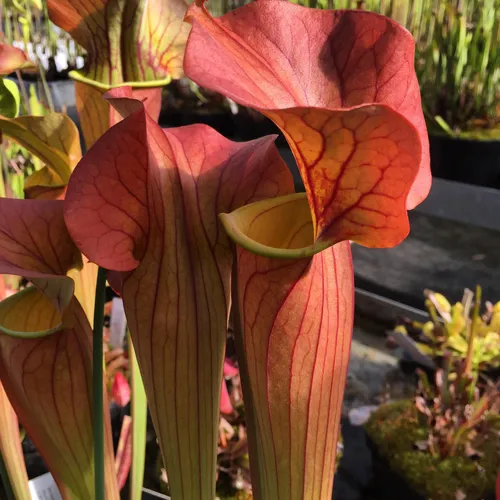 04. Sarracenia Johnny Marr, a selected form of Sarracenia x catesbaei
04. Sarracenia Johnny Marr, a selected form of Sarracenia x catesbaei It must’ve been great to be able to pay tribute to someone you’re such a big fan of, and to meet him in person!
Yeah he was over the moon with the plant - he actually got one of his guitars painted the same colours as the plant, which was great!
Given the scale of your Sarracenia hybrid program, you must be planning it years in advance, given how long it takes for the plants to mature?
Yeah I do, that’s what I need the room for! We’ve got a multi-room greenhouse covering about half an acre now, and a lot of it is growing stuff on. From seed to flowering is usually 5 years, so they need to sit there basically!
By having all that room, you can make more crosses, which gives you a better chance of really good offspring. They’re all lovely plants, but the really special ones we try to select out in the third year, usually.
I’ve always thought carnivorous plants are a great way of getting kids into horticulture. Venus flytraps are often referred to as the gateway drug, but is that still the case in your experience?
Oh yeah, children definitely love carnivorous plants. I’ve given talks at a couple of local schools, including one in Portsmouth for the last few years, and the children are all fascinated. We take a few plants along for them to look at, put a map on the wall, and the children point out North Carolina or wherever it is that the plant comes from. They look at the Sundews under their magnifying glasses, they watch the Venus flytrap closing, and the teachers always comment on what a great learning tool they are.
It’s how I started out with these plants, and hopefully these kids will catch the bug the same way.
I went on the ‘Meet the Experts’ carnivorous plant tour at Kew Gardens recently, and I was struck by how many youngsters were on the tour.
Yeah it’s great to see. I actually had a few of the people from Kew here recently, they picked up some plants from us at the end of the year, and they were saying that the carnivorous plant section gets a lot of interest now. Especially from youngsters. I think they’re currently making it over, doing up all the carnivorous plant displays, which is exciting.
Lastly, I wanted to talk about your flower shows. What goes into creating one of those stunning displays, and how long does it take to prepare?
Everyone who exhibits at flower shows has a different ‘product’ as it were, and a different way of preparing. A lot of our work has to be done before we get to the show, and our main task is growing as many large specimen plants as possible, and then - at the last minute - picking out the best of the best.
The organisers will sometimes ask you 2 or 3 months before the show what you’re bringing: “anything new?” And if you’re growing herbaceous perennials, you don’t know what they’re going to be like before they’re up! Until literally 5 or 6 days before the show, we don’t know what will go. There are things I would like to go now, to Chelsea, but we really don’t know. So it’s a lot of preparation, and growing a lot of plants.
To give you an idea, we grow a bed which is a 100 x 8 ft, and that’s just display plants for the flower shows. Out of those we’ll pick out the best of the best to go on a 15 x 8 ft table. A lot the plants are very old - some of the Sarracenia specimens we use are in 30 litre pots, and their age is often 25 to 30 years old, so they’re big old plants.
This year’s display will be a lot bigger than past years. It’s our 20th year at Chelsea - we really want to put on a spectacle, so it’ll be a huge display.
Click on any photo to zoom in. Use arrow keys or swipe to navigate.
 Hampshire Carnivorous Plants display at Tatton Flower Show in 2007
Hampshire Carnivorous Plants display at Tatton Flower Show in 2007 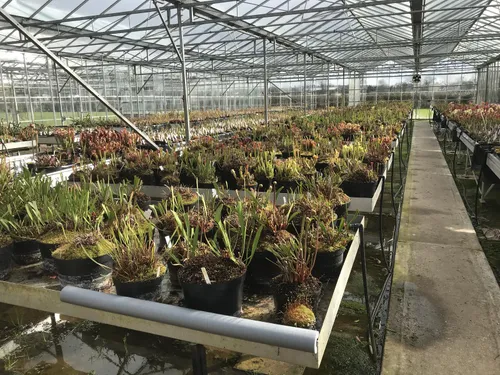 The greenhouse today. Flower buds and pitchers are starting to emerge from the dormant Sarracenia
The greenhouse today. Flower buds and pitchers are starting to emerge from the dormant Sarracenia It must be pretty stressful in that 5 week run-up to Chelsea, not knowing what you’re putting on!
Yeah you’re right. Very much so. I do worry about that a lot. In the past I’ve tried pushing the Sarracenia on with artificial lights, but you find that the ones which don’t need the lights stand out a mile. They ones needing the extra light aren’t as bright and vivid as the plants which have come up naturally.
So yeah, it is a worry… everything’s got to look good and be perfect. What helps that worry a bit is simply growing so many of them!
I’m very much looking forward to seeing the display, and to your two open days. Good luck with the preparation!
Be sure to visit the Hampshire Carnivorous Plants website and follow Matt on Instagram. If you run a carnivorous plant nursery, society, or are involved in conservation efforts to protect these magnificent plants and would like to share your story on Tom’s Carnivores, please email me.


